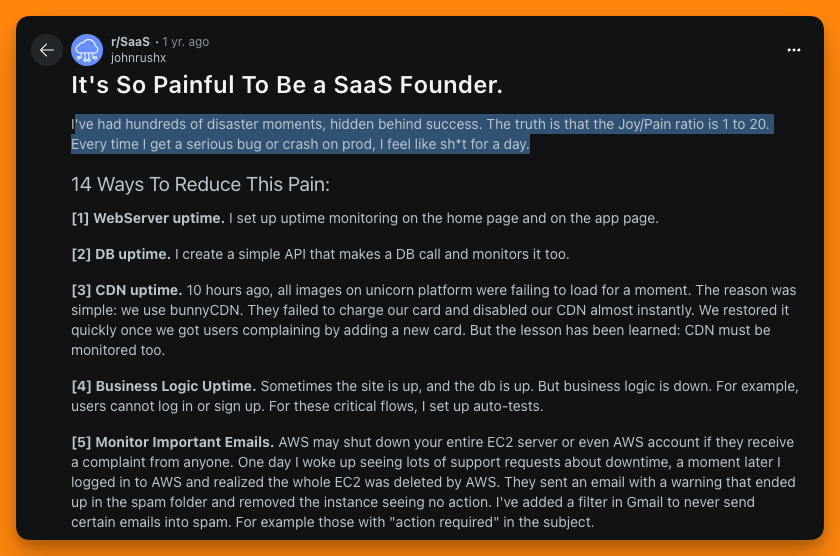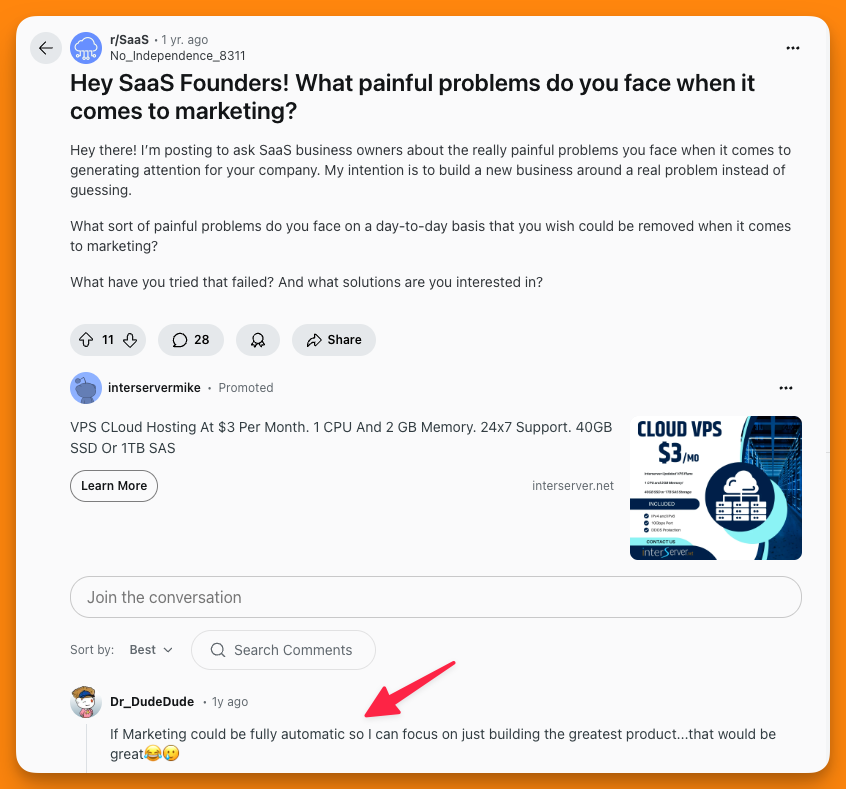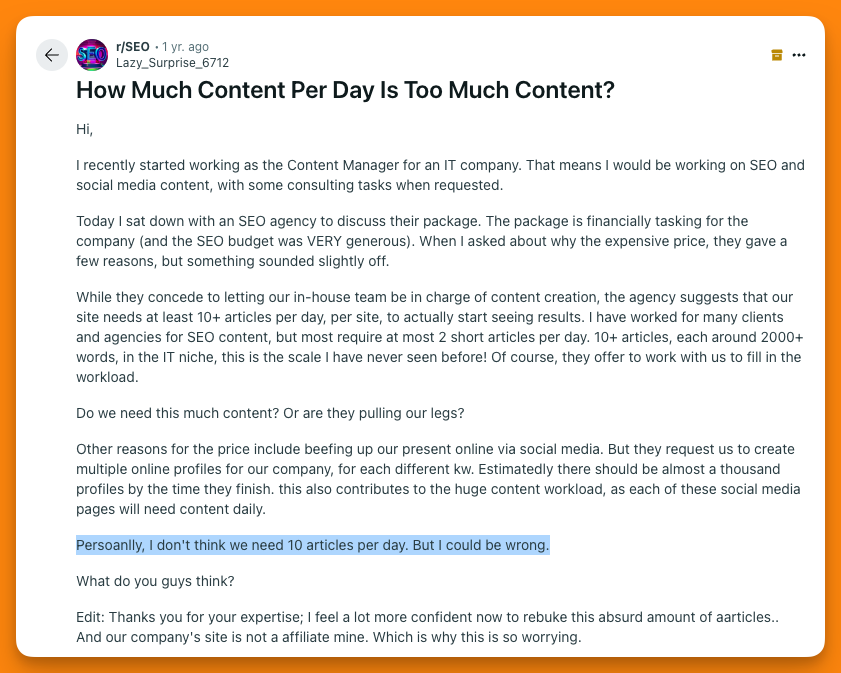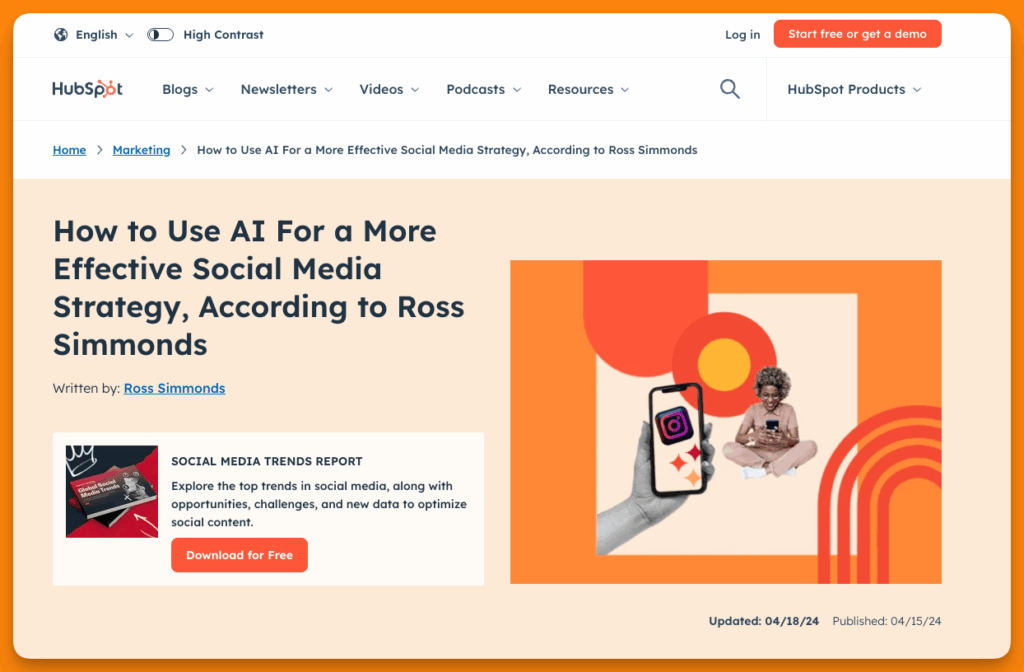Most SaaS founders hate marketing. You built your product to solve problems, not to become a content creator. After looking at what real founders say on Reddit and LinkedIn, I’ve found the actual pain points you face with content and created a guide that doesn’t waste your time.
If you are looking for a content strategy that ensures you create content that generates revenue, you’re in the right place.
In this post, I have covered the pain points of SaaS founders and have created a simple content strategy that will work like a charm, every single time.
You will not only make more revenue, but you will also save a lot of time doing random marketing tasks.
Let’s begin.
If you want to:
- Fix hidden SEO errors draining your revenue before Google notices
- Turn every blog post into a traffic magnet (no guesswork)
- Beat competitors using their own SEO playbook
- Future-proof your SEO with AI that learns as you scale
- Get expert-level audits without hiring a $200/hr consultant
The Real Content Struggles SaaS Founders Face
SaaS founders have a tough relationship with content marketing.
On Reddit, one founder admitted the “Joy/Pain ratio is 1 to 20” in running a SaaS business, with marketing being a major source of that pain.

Most founders are builders first – one founder plainly stated: “If Marketing could be fully automatic so I can focus on just building the greatest product…that would be great.”

The truth is, you’re likely facing:
- Burnout from wearing too many hats for too long
- Getting consistent leads without blowing your budget
- Trouble finding your exact market segment and creating content that fits
- Uncertainty about where to focus limited time and money (“Not knowing if I should focus on blogs for SEO, paid ads, direct outreach, or partnerships”)
Why Most SaaS Content Advice Fails You
Most content marketing advice doesn’t work for SaaS because it ignores your reality. (So does AI content)
Random blog posts without a strategy waste your time and money.
While there’s debate how much content is too much, I feel even one piece of content without a proper strategy is a waste of time.

Sure, you can attribute every single piece of content to business goals such as sales, but still, the end goal of every piece of content should be sales, directly or indirectly.
The typical content approach fails because:
- It creates busy work rather than generating leads
- It focuses on keywords rather than customer problems
- It ignores the unique aspects of your longer SaaS sales cycle
- It starts with the wrong content (general awareness pieces that never convert)
The Content Strategy That Actually Works for SaaS
Looking at successful SaaS content strategies reveals a different approach:
#1 Start with Bottom-of-Funnel Content First
As a SaaS brand, one of the first things to consider when developing your content strategy is focusing on BoFu content. This is because users at the bottom of the funnel are more likely to convert.
This means creating content like:
- Detailed “how-to” posts showing how to solve specific problems with your product
- Comparison content positioning you against alternatives
- Content that directly addresses buying concerns
Sure, you can debate that people won’t buy from you without trust. That’s why you should always pair the bottom-of-the-funnel content with top-of-the-funnel content (with content upgrades) to make sure you first deliver value to your audience & build trust with content upgrades.
You only need three types of content:
- Bottom-of-the-funnel: To convert traffic into customers
- Top-of-the-funnel (with lead magnets): To capture potential customers from the cold traffic
- Link-worthy assets: This is purely to attract natural links from the web and increase domain authority. This has nothing to do with sales. Keep it simple.
#2 Address Real Pain Points at Each Stage
SaaS founders who struggle with content often miss connecting it to actual customer pain. Your content should directly address problems your prospects face.
You can’t solve a problem that you don’t know much about. That’s why several founders preach “scratch your own itch.”
Here’s a good watch supporting this mindset👇🏻
Most of the time, the products you build are out of hallucinations. No market research, no validation, no sales.
Scratching your own itch will make sure you have enough to say when you market the product to the audience with similar problems. You will have a living experience while demonstrating.
#3 Map Content to Customer Awareness Levels
A practical framework that can bring results repeatedly is creating content based on five customer awareness levels:
- Unaware: People don’t know they have a problem
- Problem aware: They recognize the problem but don’t know about solutions
- Solution aware: They know solutions exist, but not about your product
- Product aware: They know about your product but aren’t convinced
- Most aware: They understand your product but need a final conversion push
This framework helps you create targeted content for each stage, rather than posting randomly.
When you pick a topic for your content calendar, map topics with the stages mentioned above, this way, you will have complete control over your content and the conversions that happen with it.
#4 Focus on Building Authority
No matter what Google says, links are here to stay. The algorithm sees links as a vote of confidence. However, it can also determine the relationship between natural links and paid links.
Therefore, to build domain authority fast, you need to create link-worthy assets that get natural links from the industry.
These link-worthy assets are so unique and helpful that it becomes nearly impossible to beat them on SERPs.
Take a look at this blog post from Live Plan.

This has got a backlink from HubSpot to a post that’s evergreen and relevant for potential customers.
Link-worthy assets can be:
- Comprehensive guide
- Real-life case study
- Original research
- Functional tools
Don’t hurry into creating the link-worthy assets. Take your time creating them for your business. It’s one time creation and forever fruition.
Links help you boost domain authority, which further increases the chances of other pages ranking faster.
For example, I published this post on my blog in Dec’24.
I chose a unique angle for a generic use case. Within the first week, the post got indexed in Google search, and at present, this post alone is getting over 130k impressions & is consistently getting 103 clicks for free.
Now that the page is performing well, I can capitalize on this traffic by generating leads from it. Even a 2%-3% conversion rate would bring in a lot of revenue to my business.

If you look at the post carefully, it’s a perfect link-worthy asset because it covers search strings any business can use to find link-building opportunities from Google search. No paid tool required.
Fun fact: I haven’t optimized even a single line since I published it. No link-building outreach either. These impressions are a validation that I can rank #1 for this keyword.
Publishing just a couple of link-worthy assets a month can boost your domain authority for more organic traffic from Google. Because, thanks to such pages, the search algorithm trusts you more.
Next time, when you target a keyword, you’re more likely to dominate on SERPs for that keyword.
Note: You won’t get a DA of 99 in a month. It’s a long process that takes time, like everything sustainable and good things.
#5 Create Lead Magnets for TOFU content
Most startups fail at marketing because they are targeting the wrong awareness stage with their content. Unless you’re a budget that can compete with that of HubSpot, you don’t need to publish 30-40 blogs a month.
You can get customers even with less published content. You just need to do a little bit of research to find pain points that your potential customers have and the keywords they use to search for solutions to those problems.
Sure, this is a tiring task, but when you look at the ROI, it’s worth every penny.
Let me explain this concept with an example from HubSpot.

Did you notice something different?
A lead magnet in top-of-the-funnel content.
Anybody can publish a post on “How to Use AI For a More Effective Social Media Strategy?“
But how many pair the topic with a Social Media Trends Report that will reveal potential customers from the cold traffic? Very few.
This is a classic example of content upgrades and building an email list you can sell to anytime.
This is your list. No algorithm or technology breakdown can take that away from you.
Since they have exchanged their email with you and you nurture them regularly, the trust factor & brand recall value are much higher.
This single step alone solves three problems every marketing campaign has:
- Authority
- Revenue
- Trust
Talk about competition now. Very few will qualify to compete with you if you do this one single step.
Creating Content with Limited Resources
I understand how it feels to fulfill ambitions while dealing with the lack of resources.
But don’t worry, there’s always a solution. I’ve prepared a plan for your case as well.
Here’s how to make it work:
#1 Focus on High-Impact Content First
Another reason BoFu content must be a priority is that it helps reduce your marketing budget while giving you the maximum ROI for your content marketing.
Your first pieces should be ones that directly help prospects understand how you solve their problems.
#2 Use a Simple Content Calendar
An editorial calendar is a timeline for creating your content and executing your content marketing strategy.
It helps you map out what content will be created, who’s responsible for creating it, and when it will be created.
Keep it simple – a basic spreadsheet works fine.
Map each piece to:
- A specific customer pain point
- A stage in their buying journey
- A clear next action you want them to take
#3 Balance DIY vs Getting Help
Many founders try to do everything themselves, but this creates burnout.
Bootstrapped SaaS founders are often not marketers. They are builders.
Consider:
- What content can only you create (product insights, founder journey)
- Where getting expert help actually saves money
- What can be delegated or outsourced
Validating If Your Content is Working
The hardest part for many founders is measuring success. You wouldn’t know if the ad copywriting is bad, OR the ad targets the wrong target group, OR the medium is wrong.
Focus on these simple metrics:
- Which content pieces drive actual leads
- Conversion rates from content to trial/demo
- Customer acquisition cost compared to other channels
- Feedback from prospects on what content helped them decide
Your Next Step: A Quick-Start Content Plan
If you’re struggling with a content strategy that works for you, start here:
- List the top 3 problems your product solves
- Double down on what works, cut what doesn’t
- Set up simple tracking to see which generates the most interest
- Create one detailed piece showing how your product solves each problem
What Can You Do Now?
I help SaaS founders create content that generates leads without wasting time.
My approach focuses on:
- Concentrate on the content that brings in customers
- Creating systems that work with your limited resources
- Building content strategies that directly connect to sales
If content marketing feels like a black hole consuming time with little return, let’s talk. I help SaaS founders like you turn content into a predictable lead source.

